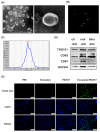Sinomenine Protects Against Morphine Dependence through the NMDAR1/CAMKII/CREB Pathway: A Possible Role of Astrocyte-Derived Exosomes
- PMID: 30227624
- PMCID: PMC6225372
- DOI: 10.3390/molecules23092370
Sinomenine Protects Against Morphine Dependence through the NMDAR1/CAMKII/CREB Pathway: A Possible Role of Astrocyte-Derived Exosomes
Abstract
Sinomenine is a nonaddictive alkaloid used to prevent morphine dependence, even thoughits mechanism isnot fully understood. Astrocytes aggravate the pathological process in their neighboring cellsthrough exosomes in central nervous system diseases. However, the effect of sinomenine on astrocyte-derived exosomes for the amelioration of morphine dependence has not been reported yet. In this study, we found that sinomenine prevented the morphine-induced conditionedplace preference in mice. Sinomenine reduced the levels of cAMP and intracellular Ca2+ in morphine-treated SH-SY5Y cells. Moreover, sinomenine inhibited the expressions of p-NMDAR1/NMDAR1, p-CAMKII/CAMKII, and p-CREB/CREB in the hippocampusof morphine-dependent mice and SH-SY5Y cells. Furthermore, we found that sinomenine inhibitedthe morphine-induced activation of astrocytesin vivo and in vitro. Afterwards, exosomes were isolated from cultured primary astrocytes treated with phosphate buffer saline (PBS, ctl-exo), morphine (mor-exo), or morphine and sinomenine (Sino-exo). Subsequently, morphine-treated SH-SY5Y cells were treated with ctl-exo, mor-exo, and Sino-exo. Results showed that Sino-exo reduced the level of cAMP, intracellular Ca2+, and the expression of p-CAMKII/CAMKII and p-CREB/CREB in morphine-treated SH-SY5Y cells. In conclusion, we demonstrated that sinomenine exhibited protective effects against morphine dependencein vivo and in vitro through theNMDAR1/CAMKII/CREB pathway. Sinomenine-induced alterationof the function of astrocyte-derived exosomes may contribute to the antidependence effects of sinomenine in morphine dependence.
Keywords: CAMKII; CREB; NMDAR1; exosomes; morphine; sinomenine.
Conflict of interest statement
The authors declare no conflict of interest.
Figures






Similar articles
-
Geranylgeranylacetone blocks the reinstatement of morphine-conditioned place preference.Neuropharmacology. 2018 Dec;143:63-70. doi: 10.1016/j.neuropharm.2018.09.027. Epub 2018 Sep 18. Neuropharmacology. 2018. PMID: 30240785
-
Sinomenine attenuates cancer-induced bone pain via suppressing microglial JAK2/STAT3 and neuronal CAMKII/CREB cascades in rat models.Mol Pain. 2018 Jan-Dec;14:1744806918793232. doi: 10.1177/1744806918793232. Epub 2018 Jul 20. Mol Pain. 2018. PMID: 30027795 Free PMC article.
-
Effect of Sinomenine on the Morphine-Dependence and Related Neural Mechanisms in Mice.Neurochem Res. 2017 Dec;42(12):3587-3596. doi: 10.1007/s11064-017-2407-5. Epub 2017 Nov 8. Neurochem Res. 2017. PMID: 29116553
-
Paeoniflorin Attenuates Cerebral Ischemia-Induced Injury by Regulating Ca2+/CaMKII/CREB Signaling Pathway.Molecules. 2017 Feb 27;22(3):359. doi: 10.3390/molecules22030359. Molecules. 2017. PMID: 28264448 Free PMC article.
-
Do pharmacological approaches that prevent opioid tolerance target different elements in the same regulatory machinery?Curr Drug Abuse Rev. 2008 Jun;1(2):222-38. doi: 10.2174/1874473710801020222. Curr Drug Abuse Rev. 2008. PMID: 19630721 Review.
Cited by
-
Bioactivities and Mechanisms of Action of Sinomenine and Its Derivatives: A Comprehensive Review.Molecules. 2024 Jan 22;29(2):540. doi: 10.3390/molecules29020540. Molecules. 2024. PMID: 38276618 Free PMC article. Review.
-
Extracellular Vesicle-Encapsulated miR-183-5p from Rhynchophylline-Treated H9c2 Cells Protect against Methamphetamine-Induced Dependence in Mouse Brain by Targeting NRG1.Evid Based Complement Alternat Med. 2021 Aug 26;2021:2136076. doi: 10.1155/2021/2136076. eCollection 2021. Evid Based Complement Alternat Med. 2021. PMID: 34484386 Free PMC article.
-
Analgesic Mechanism of Sinomenine against Chronic Pain.Pain Res Manag. 2020 May 6;2020:1876862. doi: 10.1155/2020/1876862. eCollection 2020. Pain Res Manag. 2020. PMID: 32454918 Free PMC article. Review.
-
Integrated phosphoproteomic and metabolomic profiling reveals perturbed pathways in the hippocampus of gut microbiota dysbiosis mice.Transl Psychiatry. 2020 Oct 13;10(1):346. doi: 10.1038/s41398-020-01024-9. Transl Psychiatry. 2020. PMID: 33051451 Free PMC article.
-
Biogenesis, physiological functions and potential applications of extracellular vesicles in substance use disorders.Cell Mol Life Sci. 2021 Jun;78(11):4849-4865. doi: 10.1007/s00018-021-03824-8. Epub 2021 Apr 5. Cell Mol Life Sci. 2021. PMID: 33821293 Free PMC article. Review.
References
MeSH terms
Substances
Grants and funding
LinkOut - more resources
Full Text Sources
Other Literature Sources
Miscellaneous

